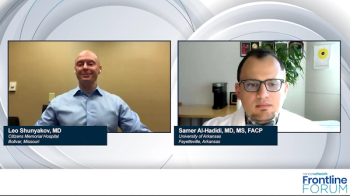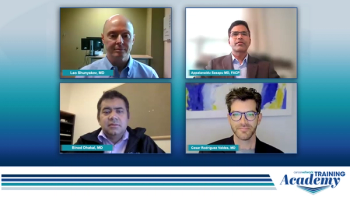Articles by Leo Shunyakov, MD

Panelists discuss how to manage talquetamab-associated adverse events, such as skin toxicities and dysgeusia, sharing their clinical experience with toxicity timing, frequency, and key strategies for fellow oncologists implementing bispecific antibodies in relapsed/refractory multiple myeloma.

Panelists discuss how they dose talquetamab in clinical practice, comparing its administration schedule to other bispecific antibodies and addressing dosing-related challenges they encounter.

Panelists discuss how they approach treatment strategies and challenges for relapsed/refractory multiple myeloma patients with CNS involvement, sharing case details and preferences among available therapeutic options.

Panelists discuss how addressing unmet needs and future directions for enhancing bispecific therapy care transitions in multiple myeloma requires focusing on standardized protocols, technology integration, personalized patient support, and continuous education for both patients and healthcare providers across academic and community settings.

Panelists discuss how optimizing patient reintegration into community care after receiving bispecific therapy for multiple myeloma at academic centers requires a coordinated, patient-centered approach involving clear communication, standardized transition protocols, ongoing education, and collaborative care models between academic and community oncologists.

Panelists discuss how enhancing communication between academic and community oncologists during the referral and treatment process for multiple myeloma patients requires a multifaceted approach involving standardized protocols, technology integration, regular collaborative meetings, and shared decision-making to ensure seamless patient care and optimal outcomes.

Panelists discuss how comprehensive long-term monitoring protocols for patients who have received bispecific therapy typically involve regular follow-ups, standardized testing schedules, and clear communication channels between academic centers and community practices to manage potential complications and adverse events.

Panelists discuss how determining a patient's readiness to transition back to community oncology care after bispecific therapy involves assessing multiple factors including treatment response, toxicity resolution, overall stability, and the community practice's capabilities.

Panelists discuss how referral types for multiple myeloma patients vary widely, including newly diagnosed cases, relapsed/refractory disease, and specific therapy considerations like bispecifics, with processes differing between in-state and out-of-state referrals due to logistical and insurance factors.

Panelists discuss how the evaluation and treatment initiation processes for non-BCMA targeted bispecifics and BCMA-targeted bispecifics share core similarities in patient assessment and care coordination, but differ in specific premedication protocols, dosing strategies, and side effect management.

Panelists discuss how academic centers approach the initial consultation and evaluation process for patients referred for bispecific therapy from community practices.

Panelists discuss how transitioning patients with multiple myeloma from community to academic settings faces challenges including communication gaps, differences in treatment approaches, patient reluctance, and logistical hurdles.

Panelists discuss how patient-specific factors such as disease status, overall health, support systems, and treatment history are crucial considerations when determining readiness for potential transition to community settings for ongoing care.

Panelists discuss how the initial process of identifying and referring potential candidates for bispecific therapy from the community setting to an academic center involves careful patient assessment, clear communication channels, and established referral protocols to ensure timely and appropriate treatment initiation.

Panelists discuss how multiple myeloma care faces challenges including patient reluctance to seek treatment at academic centers, complex treatment landscapes, and the need for improved coordination between community and academic physicians.

Panelists discuss how collaborative care settings for multiple myeloma patients often lead to improved outcomes compared to non-collaborative approaches, citing factors such as access to specialized expertise, coordinated treatment plans, and comprehensive patient support.

Panelists discuss how streamlining the referral process for multiple myeloma patients can significantly reduce treatment initiation.

Panelists discuss how effective collaboration, care coordination, and communication between academic and community physicians are crucial for ensuring seamless transitions and high-quality care for patients with multiple myeloma.





